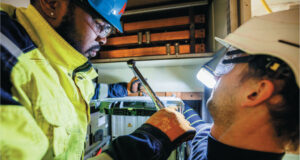As our infrastructure ages, some say that grout failures are inevitable. However, poor base installation practices often reduce the life of our equipment. Here are some examples.
Failure to remove laitance
The strength in concrete comes from the aggregate. When a concrete base is poured, the top 1 or 2 inches contains no aggregate and should be removed before grouting to allow the grout to bond to the aggregate.
Poor base leveling techniques

Fig. 1: Common practice—the anchor bolts only compress the hard shims when torqued.
Grout needs to be placed into compression to be effective. A common practice is to use hard shims placed close to the sole plate anchor bolts to level the base prior to grouting (Fig. 1). Upon torqueing the anchor bolts, the shims are placed in compression and not the grout. This leads to premature failure of the grout.

Fig. 2: Best practice—anchor bolts compress the grout when torqued (after removing leveling screws).
A better technique is to use independent leveling screws to level the sole plate. The grout is then poured as usual (Fig. 2). Once the grout has cured, the leveling bolts are removed and the anchor bolts torqued to the correct specification. This places the grout into compression.
Contributed by Reliability Solutions: www.reliabilitysolutions.net
 Paper 360
Paper 360
